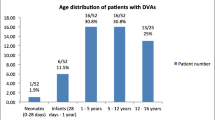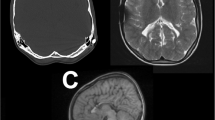Summary.
Summary.
Background:
Spontaneous intracranial haemorrhage is not common in infants, with differences from adults in both aetiology and severity. The infantile CNS is more vulnerable because of incomplete hydrovenous maturation. We analyzed infantile intracranial haemorrhage mainly caused by structural brain lesions and discuss specific aetiologies with regard to haemodynamic characteristics.
Subjects and Methods:
We reviewed 20 infants less than 2 years of age from a total of 328 neonates and infants with intracranial vascular lesions seen in our institution since 1985. Associated or causative lesions were arteriovenous malformation (AVM) in 6, dural sinus malformation (DSM) in 4, arteriovenous fistula (AVF) in 3, aneurysm in 2, developmental venous anomaly (DVA) in 1, vein of Galen malformation (VGAM) in 1, and others in 3. The locations of haematomas were intracerebral (ICH) in 8, combined ICH and intraventricular haemorrhage (IVH) in 5, IVH alone in 5, subarachnoid haemorrhage (SAH) in 1, and combined SDH and ICH in 1.
Findings:
Three patterns of haemorrhage were noted in high-flow vascular lesions such as AVM or AVF (n=9); haemorrhage at the site of nidus or fistula corresponding to nidal pseudoaneurysm in 4, regional venous hypertension with pial venous reflux in 3, global venous infarction causing multifocal haemorrhage in distant brain areas in 2.
Aneurysmal bleeds were caused by dissecting aneurysms at the level of dural penetration of cranial vessels. One infant had haemorrhage near a DVA without evidence of cavernous malformation suggesting the possibility of venous ischaemia. IVH was associated with shunt operations in 4 infants with DSM, and SDH followed by ICH in a infant with VGAM.
Interpretation:
Spontaneous intracranial haemorrhage in infants and neonates is rare; it is associated with specific lesions which show some differences from their adult counterparts. The vein-related causes of hemorrhage are largely the pathophysiologic characteristics in this age group. Absence of hemorrhage in VGAM is remarkable in addition to occurrence of most hemorrhages after shunting.
Similar content being viewed by others
Author information
Authors and Affiliations
Rights and permissions
About this article
Cite this article
Chul Suh, D., Alvarez, H., Bhattacharya, J. et al. Intracranial Haemorrhage Within the First two Years of Life. Acta Neurochir (Wien) 143, 997–1004 (2001). https://doi.org/10.1007/s007010170004
Issue Date:
DOI: https://doi.org/10.1007/s007010170004




